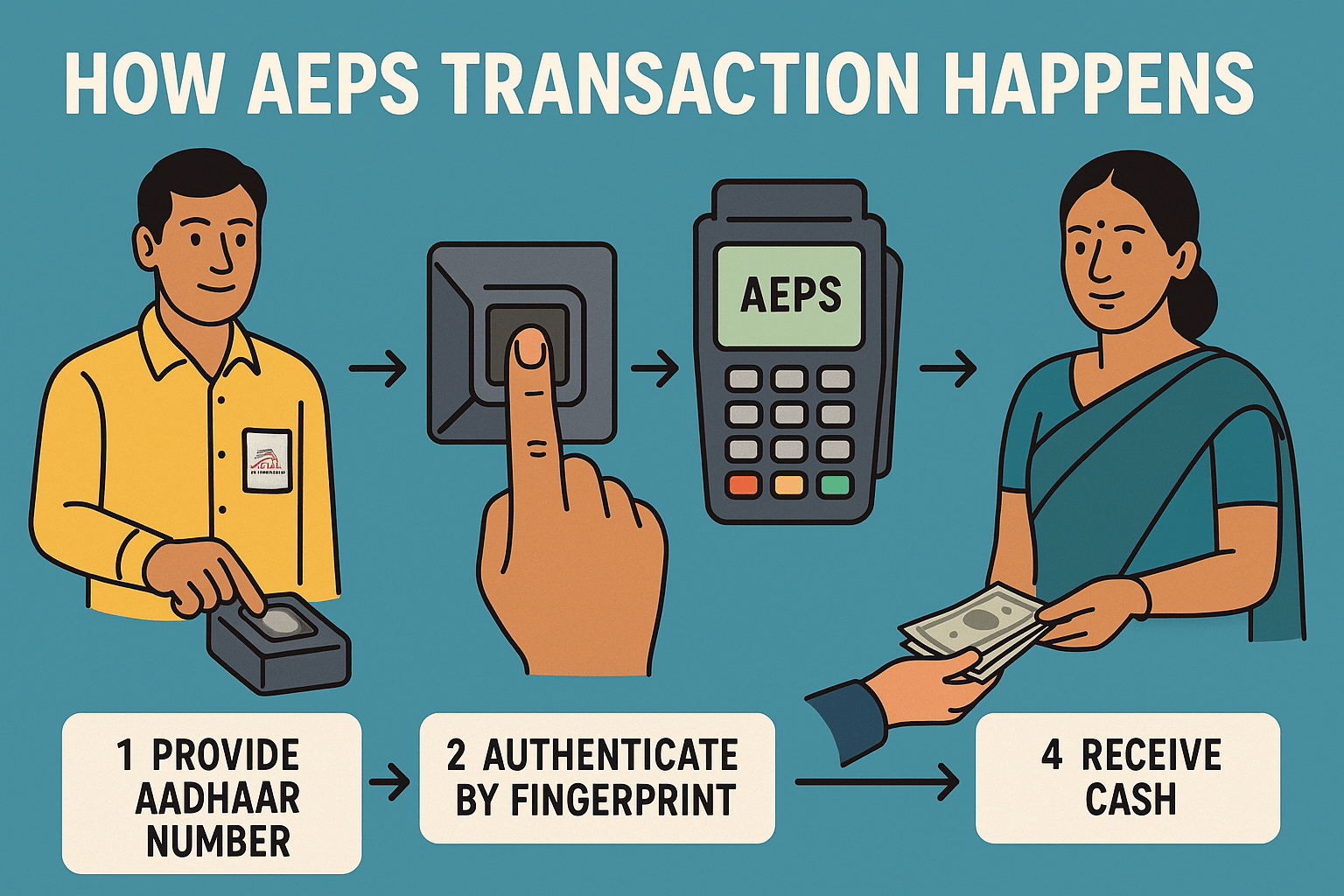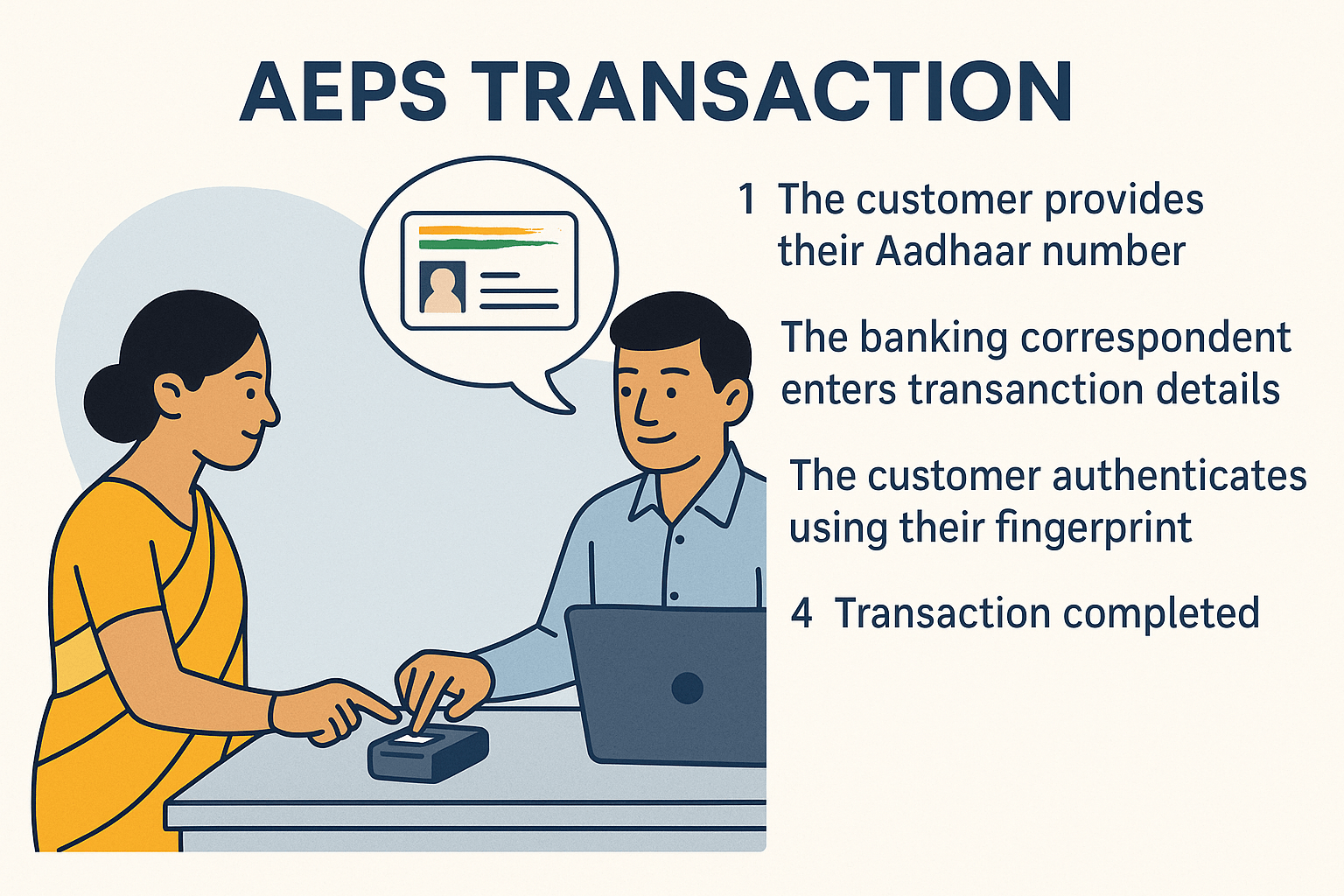Imagine needing to check your bank balance or (How Does AEPS Transaction Happen) withdraw cash but realizing you’ve left your wallet, debit card, and phone at home. A few years ago, this would have been a major problem. Today, thanks to the Aadhaar Enabled Payment System (AEPS), you can still access your money. This revolutionary system has transformed financial inclusion in India, bringing banking services to the most remote corners of the country. But how does AEPS transaction happen exactly? Let’s break down the magic behind this simple yet powerful technology.
AEPS is a bank-led model that allows you to carry out basic financial transactions using only your Aadhaar number and biometric authentication (your fingerprint or iris scan). It’s a cornerstone of India’s Digital India initiative, designed to empower every citizen with direct access to their bank account, bypassing the need for physical cards or remembering complex PINs.
The Core Architecture: The Players Behind an AEPS Transaction
To understand how an AEPS transaction flows, you need to know the key players involved:
-
You (The Customer): The individual with an Aadhaar number linked to a bank account.
-
Micro-ATM (The Point of Sale Device): The handheld machine at the banking correspondent (BC) or merchant outlet that captures your Aadhaar number and fingerprint.
-
Banking Correspondent (BC) or Merchant: The authorized person who operates the micro-ATM and assists you with the transaction.
-
Your Bank (Issuer Bank): The bank where you hold your account.
-
NPCI (National Payments Corporation of India): The brains of the operation. NPCI acts as the central switch that securely routes transaction requests between different banks.
-
UIDAI (Unique Identification Authority of India): The authority that verifies your biometric data (fingerprint/iris) against its central database to authenticate that it is really you.
The Universal AEPS Transaction Flow: A Step-by-Step Journey
Regardless of the type of transaction—balance inquiry, cash withdrawal, or deposit—the core process remains largely the same. It’s a seamless digital handshake between multiple entities, all happening in a matter of seconds.
Here is a simplified flow of how an AEPS transaction happens:
You visit a nearby BC outlet (often a local kirana store) and specify the transaction you want to perform—say, a cash withdrawal. The BC agent selects the transaction type (e.g., “Cash Withdrawal”) on their micro-ATM device.
Step 2: Data Input
You will be asked to enter your:
-
Aadhaar Number (on the micro-ATM keypad)
-
Bank Name (where your account is held and Aadhaar is linked)
-
Biometric Data (you place your finger on the fingerprint scanner attached to the device).
Step 3: The Request is Routed
The micro-ATM, owned by the BC’s bank (known as the Acquiring Bank), encrypts your data and sends the transaction request to the NPCI switch.
Step 4: NPCI Directs the Traffic
NPCI identifies which bank your account is with based on the details provided and routes the request securely to that specific bank (your Issuer Bank).
Step 5: Bank and UIDAI Authentication
Your bank receives the request and immediately sends the biometric data to UIDAI for verification. UIDAI checks its database to confirm the fingerprint matches the Aadhaar number provided. It sends a “Yes/No” authentication response back to your bank.
Step 6: Transaction Authorization
If UIDAI confirms “Yes,” your bank then checks its own records to see if the Aadhaar number is correctly mapped to your account and if you have sufficient balance (for a withdrawal). If everything is in order, the bank approves the transaction.
Step 7: The Return Journey
The authorization (or denial) message travels back along the same path: from your Bank -> to NPCI -> to the Acquiring Bank -> to the micro-ATM.
Step 8: Completion
The micro-ATM displays the transaction result. If approved, the BC agent hands you the cash (for withdrawal) or accepts your cash (for deposit) and provides a printed receipt. The entire process is incredibly fast, often completed within 15-20 seconds.

Detailed Steps for Specific AEPS Transactions
While the overarching flow is identical, the end-action differs. Here’s what happens at the bank level for each type.
1. How to Check Balance with AEPS
This is the simplest transaction as it doesn’t move any money.
-
Your Action: Provide Aadhaar, select bank, give fingerprint.
-
The Bank’s Action: After successful biometric authentication, your bank simply fetches the latest available balance for your Aadhaar-linked account and sends this data back through the NPCI switch to the micro-ATM for display.
-
Example: Rajesh in a village uses his fingerprint at a local shop to check if his pension has been credited. He sees his balance of ₹5,200 on the screen and gets a confirmation receipt.
2. How to Withdraw Cash with AEPS
This is the most popular AEPS service.
-
Your Action: Provide Aadhaar, select bank, give fingerprint, and tell the BC the amount you wish to withdraw (e.g., ₹2,000).
-
The Bank’s Action: After biometric authentication, your bank checks if your account has a sufficient balance. If yes, it places a “hold” on ₹2,000, effectively deducting it from your available balance. It sends an approval message. The BC then hands you ₹2,000 from their cash float.
-
Example: Priya needs cash at a busy market but has no card. She withdraws ₹1,500 from her account using her fingerprint at a chemist shop acting as a BC outlet.
3. How to Deposit Cash with AEPS
This allows you to add money to your account.
-
Your Action: Provide Aadhaar, select bank, give fingerprint, and hand over the physical cash (e.g., ₹3,000) to the BC.
-
The Bank’s Action: After biometric authentication, your bank approves the deposit request. The BC enters the amount into the micro-ATM. Your bank then credits your account with ₹3,000. The BC keeps the physical cash, which is reconciled with their bank later.
-
Example: A small vendor, Abdul, ends his day with ₹4,000 in cash. He deposits it directly into his bank account at a BC outlet near his stall instead of holding the cash overnight.

The Power and Security of AEPS: Why It Matters
-
Financial Inclusion: AEPS has been a game-changer for rural India, bringing formal banking services to millions who were previously unbanked or underbanked. According to a report by the World Bank, such digital public infrastructures have been crucial in expanding financial access.
-
Security: Your biometrics are unique. It eliminates the risk of fraud due to stolen cards or forgotten PINs. The transaction is secure as no sensitive financial data is shared with the merchant; the entire process is encrypted and routed through secure NPCI channels.
-
Convenience: No need to carry multiple cards or remember multiple PINs. Your identity is literally at your fingertips.
Challenges and the Future
AEPS is not without its challenges. Transaction failures due to poor internet connectivity in remote areas, biometric authentication failures (worn-out fingerprints from manual labor are a common issue), and ensuring a sufficient cash float with BC agents are ongoing hurdles. However, the future is bright. The integration of Aadhaar with UPI is the next evolutionary step, combining the identity layer of Aadhaar with the payment power of UPI.
Frequently Asked Questions (FAQs)
1. Is it mandatory to link my bank account with Aadhaar to use AEPS?
Yes, your bank account must be linked with your Aadhaar number for the AEPS transaction to work. The bank uses your Aadhaar number to identify your specific account.
2. What if my fingerprint doesn’t work?
This is a common issue. You can try a different finger. If authentication consistently fails, you should visit your bank branch to update your biometrics in the UIDAI database.
3. Are there any charges for using AEPS services?
The government often promotes zero-charge transactions for AEPS to encourage digital payments. However, some banks or BC agents might levy a nominal fee, especially for cash withdrawals. It’s always best to check with the agent beforehand.
4. How can I find a nearby AEPS outlet?
You can search online for “AEPS service near me” or use your bank’s mobile app or website, which often has a feature to locate nearby banking correspondent outlets.
5. Is AEPS safe?
Yes. The system does not require you to share your bank details or PIN with the merchant. Your biometric data is not stored on the micro-ATM; it is only used for verification with UIDAI, making it a highly secure method of authentication.
Conclusion: Banking Simplified
Understanding how does AEPS transaction happen reveals the incredible power of a well-designed digital public good. It’s a complex symphony of technology involving banks, NPCI, and UIDAI, yet for the end-user, it’s breathtakingly simple: quote your Aadhaar number and press your finger. By demystifying the steps for balance checks, withdrawals, and deposits, we can appreciate how AEPS has truly democratized access to finance, empowering every Indian citizen with the keys to their economic future.
Disclaimer: This article is for educational and informational purposes only. The specific processes, charges, and features of AEPS are subject to change as per guidelines from NPCI, UIDAI, and individual banks. While we strive for accuracy, we do not claim it to be exhaustive or absolutely current. If you have any concerns about the content published here, please refer to our DMCA policy page for guidance on content removal and verification of ownership.
